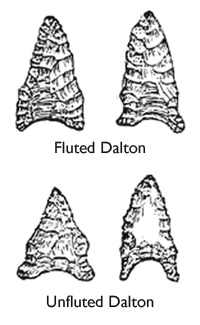Dalton tradition facts for kids
The Dalton tradition is a name for a special time in history when early people in North America made unique stone tools. These tools, especially their spear points, are called Dalton points. They were used by groups of people living in the southeastern part of North America a very long time ago, between about 12,000 and 9,500 years ago. This period is known as the Late Paleo-Indian and Early Archaic times.
Contents
What Were Dalton Points?
A Look at Their Design
Dalton points are easy to spot because of their special shape. They have a curved-in, or "concave," base. This base often has "ears" that sometimes stick out. These points were not just for hunting. They were also used as saws and knives.
How Were They Used?
Hunters often sharpened these points over and over. As they sharpened them, the points would change shape. A spear point might become a knife. Then, it could be sharpened even more to become a chisel or a scraper. This shows how clever these early people were at making their tools last.
Where and When Did They Exist?
Dalton points appeared across most of the southeastern part of North America. This was around 10,000 to 7,500 BC. That's a very long time ago! It was during the end of the Paleo-Indian period and the start of the Archaic period.
What Does Paleo-Indian Mean?
The Paleo-Indian period was when the first people arrived in North America. They were often hunters of large animals.
What Does Early Archaic Mean?
The Early Archaic period followed the Paleo-Indian time. People started to adapt to different environments. They used a wider range of plants and animals for food.
Related Tools
A tool similar to the Dalton point is the Hardaway point. This type of point was found in North Carolina. It shows that different groups of people might have made similar tools. Or, they might have shared ideas about how to make them.


